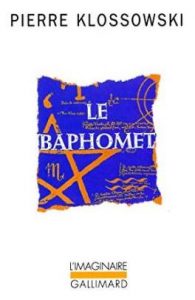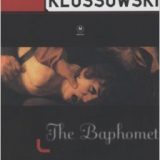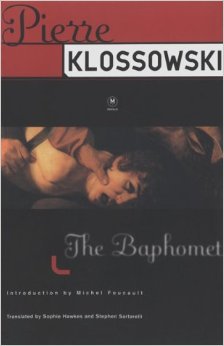The Baphomet – Pierre Klossowski – 1965

The following is a compilation of discussions and reviews from the previous version of our website. We hope you enjoy these older deliberations. Just beware, there may be spoilers in here. To add your own review or remarks, please scroll down to the comment box. — ReadLit Team
Posted by joffre on 29/1/2016, 19:33:23
Well, for starters, I don’t know much of anything about the Templars. I’ve never read Ivanhoe, though I am considering it now. I follow the prologue well enough, but a bit of history would probably help.
I find this chamber of bellows rather hard to visualize. I gather this bronze serpent is some kind of medieval machine meant to inspire faith in people who must have thought God made it work.
The long speech by Theresa is rather difficult to follow even with focus. I don’t know anything about this Theresa either.
~
Posted by Steven on 29/1/2016, 21:52:45
The short version: What Teresa of Avila and the Knights Templar have in common is the connection between religion and sexuality, something explored at length by Klossowski’s mentor Georges Bataille. Teresa was a mystic who described her religious ecstasy in orgasmic terms, while the Templars were accused of worshiping a pagan idol, the Baphomet, and conducting rituals including sodomy.
I haven’t started the novel yet, so I don’t know anything about the chamber of bellows.
~
Posted by Steven on 31/1/2016, 20:48:29
Before starting The Baphomet, I did some background reading on Gnosticism, and that is helping a lot. After the prologue, all of the characters in the novel (so far) are the disembodied spirits of the dead, seen as swirling breaths of air. The spirit of the Grand Master uses the bellows to capture and interrogate other spirits. He is looking for the spirit of St. Theresa who spoke to him as he died. The brass serpent is the Gnostic emblem of the Ouroborous, the snake swallowing its own tail, which symbolizes eternity.
Some Gnostics believe that souls can be reincarnated multiple times until they achieve the purity necessary to enter gnosis, the final oneness with God (the supreme being, or “monad,” not the creator god who is a lesser being). But, in the novel, God isn’t taking in any more souls, so the spirits are piling up on earth. Theresa is one of the blessed, but she has been granted a dispensation to hang around looking after the soul of her former confessor. Yet after several reincarnations, he reveals himself to have had only physical interest in her, not spiritual.
I can’t say for sure, but I suspect that this resurrected confessor and his once-pure wife are Octave and his wife Roberte, the characters from Roberte Ce Soir and subsequent writings. This is because each of the husbands is accused of giving his wife to his friends and later selling her favors to strangers. Curiously, Octave is said to be an autobiographical character.
I also think the character from the Prologue, Valentine de Saint-Vit, Lady of Palençay, may be a previous incarnation of Roberte.
Klossowski gave up writing for painting, and if you Google his name and look at “images,” you’ll see a lot of his art. Many of the works illustrate scenes from his writings. Roberte is a frequent subject. She is the narrow-faced woman with her hair coiled on her head. She is usually depicted having sex or being raped. But you might take her for young man when depicted nude because of her androgynous appearance. The author explains that her organ of arousal, when stimulated, is comparable in dimension to the analogous organ of a boy. (I hope I said that delicately enough.) Klossowski used his wife Denise as a model for the paintings. He also made a movie titled “Roberte” in which he and Denise acted the parts of Octave and Roberte.
~
Posted by joffre on 1/2/2016, 23:50:07
You seem to have a much better grasp on the story than I do.
Conrad said, I think in the preface to Nostromo, that above all, he wanted to make us see. I tend to think that in reading what is most important is to be able to visualize. I have no trouble in the beginning of The Baphomet. It’s fun to visualize the expired breath of Jacques swirling around with other breaths going through him, etc. But at some point, I become quite confused about what’s going on. Is the place they are in physical; does it exist in the present, or is it just a memory or has the story just moved back in time or what? Is Ogier still hanging there in that tower? When is he hanging there in that tower?
Why is Nietzsche an anteater?
Thanks for the background info. I did know some of that. The rest is interesting.
~
Posted by Steven on 2/2/2016, 12:01:32
My interpretation was that everything that takes place after the prologue is happening to the swirling breaths, not real bodies, though there is at least one sequence in which the Grand Master is dreaming himself back in his body. Yet it does still seem to be a material existence as though they are occupying the physical space of the tower where Ogier’s body still hangs. Or it could all be an interaction on the spiritual level that just simulates a physical environment (not unlike some of today’s cyberpunk fiction where people are living a simulation).
I have no idea why Nietzsche is an anteater. I did some googling to see if there was some connection or some special symbolic significance of anteaters, but I couldn’t find anything. Perhaps it is just because it’s such an absurd and unlikely thing.
~
Posted by joffre on 5/2/2016, 15:50:38
Well, I finished The Baphomet last night. I actually read it twice this time, once rather quickly and again trying to slow down and concentrate. Unfortunately, I have a lot on my mind these days and still feel I didn’t read it very well.
I am intrigued by the novel. I would like to feel that I’ve followed it closely and more or less understood all that happened. Some weird stuff happens though. I’m not even sure a story that occurs outside of time can be understood in the same way a normal story can be.
I suppose it’s pointless to wonder how Theresa of Avila merged with some boy named Ogier to become the Baphomet. I’m not sure that’s even an accurate description of what happens.
I guess I’ll read this again someday but not for a few years.
~
Posted by joffre on 9/2/2016, 22:26:43
Have you seen this?
http://www.dalkeyarchive.com/reading-pierre-klossowski/
~
Posted by joffre on 9/2/2016, 22:37:44
Something else I found:
On 14 June 1965, Roger Caillois resigned from the jury of the prestigious Prix des Critiques. His resignation was provoked by the majority decision of the jury to award the critics’ prize that year to Klossowski’s final novel, Le Baphomet. Le Baphomet, a singular, Walter Scott-inspired tale about the Knights Templar, is set, initially at least, at the beginning of the fourteenth century just before the dissolution of the Templar Order at the behest of the then French king, Philippe Le Bel. After the historical prologue the action is transferred to a seemingly atemporal sphere, where the disembodied souls of the former Knights Templar await the moment when the Last Judgment will be pronounced and they will be reunited once more with their earthly bodies. The setting, tone, and style are at first gothic, but with the appearance of the disembodied spirit of Saint Teresa of Avila baroque elements begin to dominate and to mix with evocations of Masonic and esoteric ritual, Gnostic heresy, and theological but also philosophical discussion. These are accompanied by the appearance of Philippe le Bel himself and the figure of Friedrich Nietzsche, the “Antichrist,” initially in the form of an anteater. With its unorthodox and often archaic vocabulary and syntax and, after the historical prologue, its discontinuous and fantastical narrative presentation, in which the boundaries between persons and identities appear permeable and insecure, Le Baphomet engages the reader in a textual experience that can be both baffling and obscure. It is also a work that can appear to lack any intellectual or formal coherence, one whose multiplicity and evident complexity may seem to promise rich possibilities of interpretation and literary value but whose narrative disorder and stylistic singularity can ultimately leave the reader frustrated with the sense of having been exposed to something of a literary mess.
This, at least, was the view of Roger Caillois when he resigned in protest at the decision of the Prix des Critiques jury to confer its honor on Klossowski’s novel.
~
Posted by Steven on 10/2/2016, 10:27:55
The Dalkey article is the most thorough piece on Klossowski I’ve seen, but much of it is still beyond me. Maybe I’m jaded, but he seems to overstate the erotic element relative to the spiritual.
The piece on Callois is a good summary of The Baphomet (though we still have no idea why Nietzsche was an anteater) and reflects a problem I, and I’m sure many others, have with recent literature, art and music. We are never sure if we are looking at an inspired work of genius or a jumbled mess.
~
Your comments are very welcome. Please sign in and use the contribute box below to write a review or to add your comments. You may also enjoy our Talk Literature page for active discussions.















